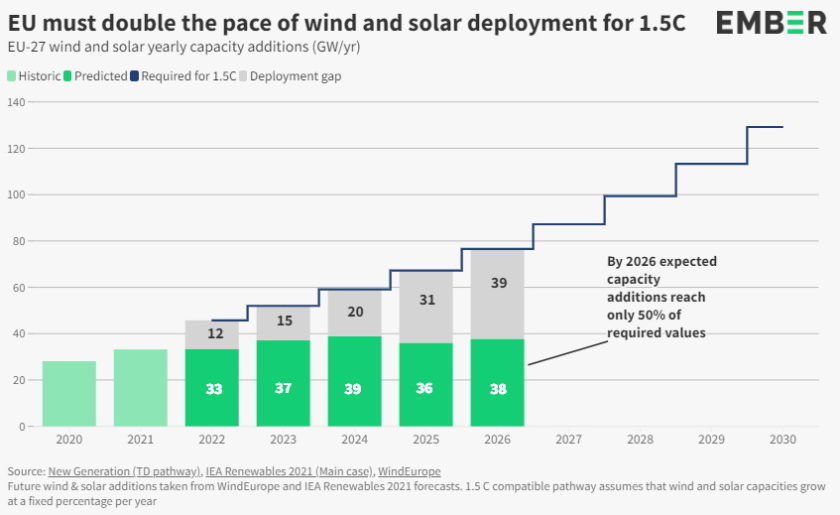
Photo: MrRenewables Westmill Solar Co-operative, Neil Maw / https://creativecommons.org/licenses/by-sa/3.0/legalcode
The EU will need to constantly accelerate the annual deployment of solar and wind, and double the plan for 2026, to deliver on the goal to hold global warming at a maximum of 1.5 degrees. Only four out of 27 member countries are set to hit the wind capacity target, and Croatia is one of them. Solar is looking slightly better but forecasts are still behind what’s needed.
The permitting process for wind and solar power projects in the European Union is a major barrier for the renewables industry, Ember said in a report called Ready, Set, Go: Europe’s race for wind and solar. The energy and climate think tank revealed that obtaining permits for a wind project can take up to 120 months, five times longer than the binding limit. 7
Croatia has the slowest permitting process in the EU, but it is still seen meeting the 1.5-degree goal by 2026 in the wind power segment
According to information collected from developers and industry bodies, solar permitting times range from 12 months in Lithuania to 48 months in Croatia. Of the 12 countries with available information, making up 91% of installed solar capacity, only Belgium, Lithuania and Romania had permitting times shorter than the EU limit of 24 months.

Romania has shortest permitting time for wind power projects in EU
Onshore wind permits take even longer, ranging from 30 months in Romania to 120 months in Croatia. None of the 18 countries analyzed were below 24 months. Together, they make up 96% of installed wind capacity.
Still, Ember calculated that Croatia is in the small group of member states, with Finland, Lithuania and Sweden, that are predicted to achieve sufficiently high annual wind capacity increases to align with the goal to keep global warming at no more than 1.5 degrees Celsius.
By mid-decade, planned annual wind and solar capacity additions in the EU must double to reach the climate targets, the report shows. The European Commission’s REPowerEU plan is aimed at reaching 1.24 TW of renewable capacity by 2030, compared to a target of 1.08 TW under previous plans, and the 513 GW of installed capacity registered for 2021.
Annual additions must become four times higher by 2030
In 2021, the EU deployed 34 GW of combined wind and solar capacity. Reaching 1.5 degrees implies yearly additions climbing to 76 GW by 2026. Current projections indicate a level of 38 GW, Ember pointed out.
Germany’s new renewabes promotion scheme is a bright spot in the EU
The research results revealed a steep continual increase in annual additions is necessary and that it has to rise to four times the 2021 levels by 2030.
The report’s authors also pointed to Germany’s new and ambitious schedule to add 10 GW per year of onshore wind capacity from 2025 and 19 GW of offshore wind between 2026 and 2030. It would put the country on track to reach a total of 145 GW in wind capacity by 2030 and aligned with the 1.5-degree benchmark.


















Be the first one to comment on this article.